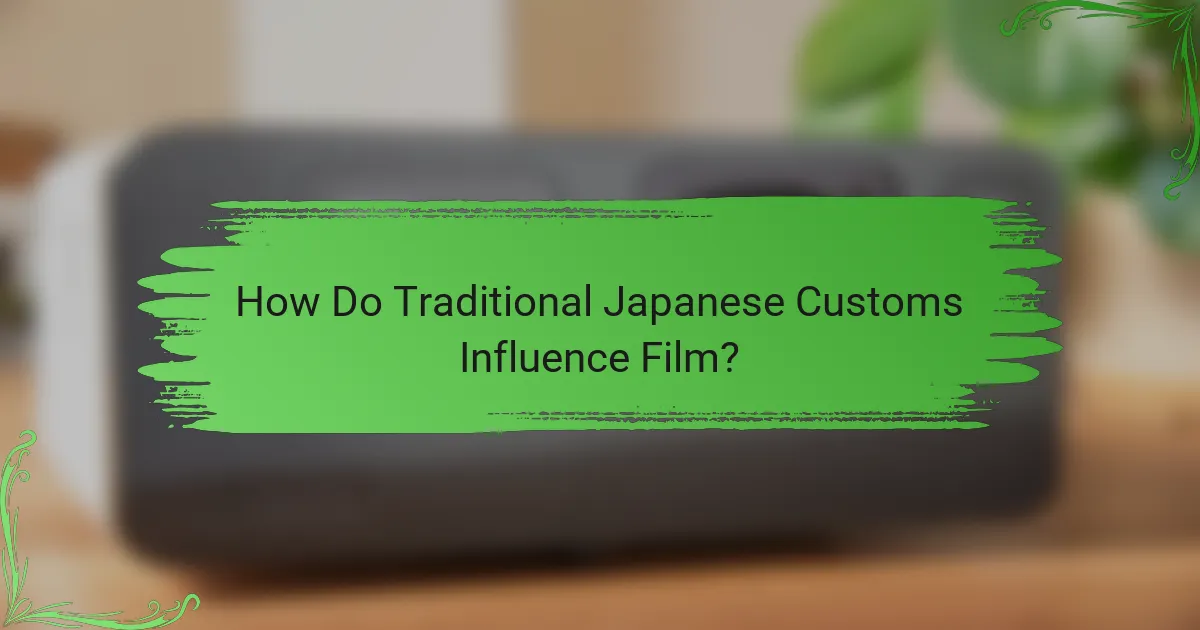Japanese movies often highlight the significance of traditional festivals, known as “matsuri,” which are essential for preserving cultural heritage and fostering community spirit. These films incorporate elaborate rituals and vibrant celebrations, providing rich cultural contexts that enhance storytelling. Notable works like “Spirited Away,” “Ikiru,” and “Rashomon” offer profound insights into Japan’s customs and values, showcasing the country’s diverse cultural tapestry.

What Are the Key Japanese Festivals Celebrating Cultural Heritage?
Japanese festivals, or “matsuri,” play a vital role in preserving cultural heritage, showcasing traditional customs, and fostering community spirit. Key festivals often involve elaborate rituals, vibrant parades, and seasonal celebrations that reflect Japan’s rich history and regional diversity.
Gion Matsuri in Kyoto
The Gion Matsuri, held in July, is one of Japan’s most famous festivals, originating in the 9th century to appease the gods during a plague. The highlight is the grand procession of floats, known as “yamaboko,” which are beautifully decorated and pulled through the streets of Kyoto.
Visitors can experience various events leading up to the main parade, including traditional music performances and food stalls offering local delicacies. It’s advisable to book accommodations early, as the festival attracts many tourists.
Tanabata Festival
Tanabata, or the Star Festival, celebrates the meeting of two celestial lovers, Orihime and Hikoboshi, on the seventh day of the seventh month. Celebrated in early July, it features colorful decorations made from bamboo and paper, where people write their wishes on strips of paper called “tanzaku.”
Many cities hold Tanabata events with parades, fireworks, and food stalls. Participating in local celebrations can provide a unique insight into Japanese culture and community wishes.
Obon Festival
Obon is a Buddhist festival held in mid-August to honor deceased ancestors. Families gather to welcome spirits back home, often through rituals like “bon odori,” a traditional dance. Lanterns are lit to guide the spirits, and offerings are made at family altars.
Obon is also a time for family reunions, with many people traveling back to their hometowns. Be mindful that transportation can be crowded during this period, so planning ahead is essential.
Setsubun
Setsubun, celebrated on February 3rd, marks the beginning of spring in Japan. The festival involves a ritual called “mamemaki,” where roasted soybeans are thrown to drive away evil spirits and bring in good fortune. The phrase “Oni wa soto, fuku wa uchi” translates to “Demons out, luck in.”
Participating in this lively event can be fun, especially for families with children. Many temples and shrines hold public mamemaki events, making it easy to join in the festivities.
Shichi-Go-San
Shichi-Go-San, celebrated on November 15th, is a rite of passage for children aged three, five, and seven. Families dress their children in traditional clothing and visit shrines to pray for their health and happiness. The name translates to “Seven-Five-Three,” reflecting the ages being celebrated.
It’s common for families to take photographs in kimono, making it a memorable occasion. Many shrines offer special blessings and ceremonies, so checking in advance for any requirements or events is advisable.

How Do Traditional Japanese Customs Influence Film?
Traditional Japanese customs significantly shape the narrative and aesthetic elements of Japanese cinema. These customs provide filmmakers with rich cultural contexts, enhancing storytelling through the incorporation of festivals, symbolism, and traditional attire.
Representation of Festivals
Festivals play a crucial role in Japanese films, often serving as backdrops for character development and plot progression. Events like Hanami (cherry blossom viewing) or Matsuri (traditional festivals) are depicted not only for their visual splendor but also for their cultural significance, showcasing community bonds and seasonal changes.
Filmmakers frequently use these festivals to highlight themes of nostalgia, celebration, and the passage of time. For instance, a film may center around a family reunion during a summer festival, illustrating the importance of tradition in maintaining familial ties.
Cultural Symbolism in Storytelling
Cultural symbolism is deeply embedded in Japanese cinema, where elements such as nature, architecture, and rituals convey deeper meanings. For example, the use of cherry blossoms often symbolizes the transient nature of life, reflecting themes of beauty and impermanence.
Directors may incorporate traditional customs, such as tea ceremonies or Shinto rituals, to enrich narratives and provide viewers with insights into Japanese values. This symbolism not only enhances the story but also educates audiences about cultural heritage.
Traditional Clothing in Cinema
Traditional clothing, such as kimono and yukata, is frequently showcased in Japanese films, serving as a visual representation of cultural identity. The choice of attire often reflects the character’s social status, personality, or emotional state, adding layers to the storytelling.
Costume designers pay close attention to detail, ensuring that the fabrics, colors, and styles align with the historical period and setting of the film. For example, a character wearing a vibrant kimono during a festival scene emphasizes joy and celebration, while muted tones may indicate mourning or reflection.

What Are the Most Influential Japanese Movies on Cultural Heritage?
Several Japanese movies have significantly impacted the understanding and appreciation of cultural heritage, showcasing traditional festivals, customs, and values. Notable films include “Spirited Away,” “Ikiru,” and “Rashomon,” each offering unique insights into Japanese society and its rich cultural tapestry.
Spirited Away by Hayao Miyazaki
The film is deeply rooted in Shinto beliefs, reflecting Japan’s cultural heritage through its portrayal of spirits and the significance of rituals. It emphasizes respect for nature and the interconnectedness of all beings, resonating with traditional Japanese values.
Ikiru by Akira Kurosawa
“Ikiru” tells the poignant story of a bureaucrat diagnosed with terminal cancer who seeks to find meaning in his life. The film highlights the struggle against the mundane aspects of life and the importance of leaving a lasting legacy.
This movie captures the essence of Japanese culture by showcasing the value placed on community and personal responsibility. It encourages viewers to reflect on their contributions to society and the impact of their actions, aligning with the cultural emphasis on collective well-being.
Rashomon by Akira Kurosawa
“Rashomon” is renowned for its innovative narrative structure, presenting multiple perspectives on a single event, which challenges the notion of objective truth. The film explores themes of morality, justice, and human nature, set against the backdrop of feudal Japan.
This classic film has influenced not only Japanese cinema but also global storytelling techniques. Its exploration of subjective reality and the complexity of human experience resonates with traditional Japanese philosophies, highlighting the cultural significance of perspective and interpretation.

How Do Japanese Movies Portray Festivals and Customs?
Japanese movies often depict festivals and customs as vibrant expressions of cultural heritage, showcasing traditional practices and community spirit. These portrayals can range from authentic documentaries to dramatized interpretations, providing audiences with insights into Japan’s rich cultural landscape.
Documentary Films on Festivals
Documentary films about Japanese festivals offer a realistic glimpse into the rituals and celebrations that define local culture. These films typically feature interviews with participants, detailed footage of events, and explanations of the historical significance behind each festival.
For example, documentaries like “Kamakura’s Snow Lantern Festival” highlight the intricate preparations and community involvement, emphasizing the importance of preserving these traditions. Such films often aim to educate viewers about the customs, making them accessible to both locals and international audiences.
Dramatic Interpretations of Customs
Dramatic films often take creative liberties to portray Japanese customs, weaving them into narratives that resonate emotionally with viewers. These films may exaggerate certain elements for dramatic effect, yet they still reflect core aspects of cultural practices.
For instance, movies like “Spirited Away” incorporate traditional Japanese customs, such as Shinto beliefs and seasonal festivals, into their storylines. While these interpretations may not be strictly accurate, they serve to evoke a sense of nostalgia and appreciation for Japan’s cultural heritage.

What Are the Contemporary Trends in Japanese Cinema?
Contemporary trends in Japanese cinema reflect a blend of traditional storytelling and modern filmmaking techniques. Filmmakers are increasingly incorporating advanced technology and innovative narratives to engage audiences both domestically and internationally.
Incorporation of Modern Technology
The incorporation of modern technology in Japanese cinema has transformed the filmmaking process and audience experience. Techniques such as CGI, virtual reality, and advanced sound design are now commonplace, allowing for more immersive storytelling.
For instance, films like “Your Name” have utilized stunning animation and visual effects to create captivating worlds that resonate with viewers. The use of drones for aerial shots and high-definition cameras has also enhanced the visual quality of films, making them more appealing to a global audience.
Filmmakers should consider balancing technology with narrative depth. While modern tools can enhance visual appeal, a strong story remains essential for audience engagement. Avoid over-reliance on effects at the expense of character development and plot coherence.
